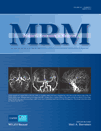Three-dimensional first-pass myocardial perfusion MRI using a stack-of-spirals acquisition
Abstract
Three-dimensional cardiac magnetic resonance perfusion imaging is promising for the precise sizing of defects and for providing high perfusion contrast, but remains an experimental approach primarily due to the need for large-dimensional encoding, which, for traditional 3DFT imaging, requires either impractical acceleration factors or sacrifices in spatial resolution. We demonstrated the feasibility of rapid three-dimensional cardiac magnetic resonance perfusion imaging using a stack-of-spirals acquisition accelerated by non-Cartesian k-t SENSE, which enables entire myocardial coverage with an in-plane resolution of 2.4 mm. The optimal undersampling pattern was used to achieve the largest separation between true and aliased signals, which is a prerequisite for k-t SENSE reconstruction. Flip angle and saturation recovery time were chosen to ensure negligible magnetization variation during the transient data acquisition. We compared the proposed three-dimensional perfusion method with the standard 2DFT approach by consecutively acquiring both data during each R–R interval in cardiac patients. The mean and standard deviation of the correlation coefficients between time intensity curves of three-dimensional versus 2DFT were 0.94 and 0.06 across seven subjects. The linear correlation between the two sets of upslope values was significant (r = 0.78, P < 0.05). Magn Reson Med, 2013. © 2012 Wiley Periodicals, Inc.




